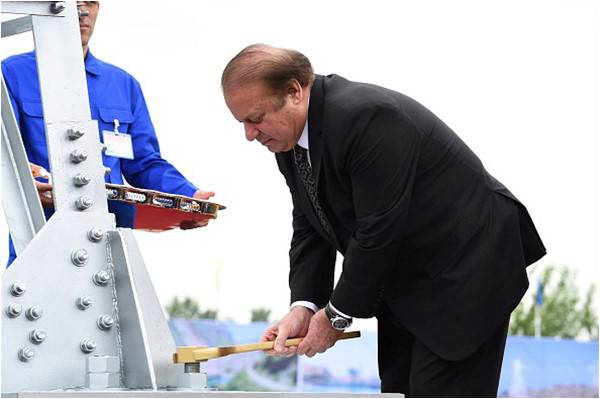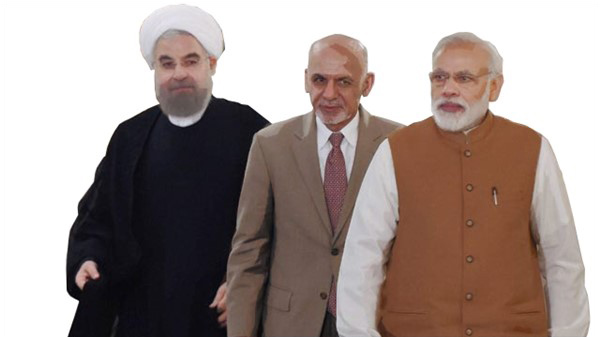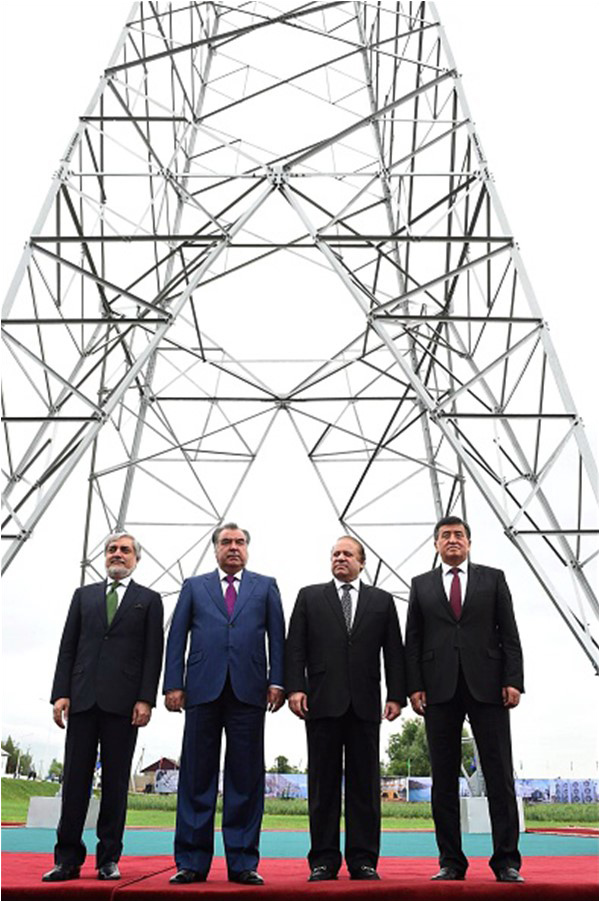
Three new initiatives in south Asia, central Asia and southwest Asia – the CASA 1000 power project, the China-Pakistan Economic Corridor (CPEC), and the Chabahar port in Iran – have the potential to transform the three regions. There is enough gas and electricity in these projects to spark an energy revolution, and if pursued in a positive manner, they can lead to substantial political and economic rewards. Gas and electricity could do for south Asia what coal and steel did for the post-WWII Europe.
CASA-1000:
Unlike the much talked about CPEC and Chahbahar initiatives, the Central Asia-South Asia power project, or CASA-1000, was pursued silently by Pakistan, Afghanistan, Kyrgyzstan and Tajikistan. The project aims to bring electricity from central Asia to south Asia through an 1100-kilometer power grid.
There have been substantial developments, meetings and agreements on the initiative in the recent months. Led by an inter-governmental council, CASA-1000 has the support of international organizations including the World Bank, USAID, and DFID, besides several other donors.
China-Pakistan Economic Corridor:
The much discussed China-Pakistan Economic Corridor (CPEC) links the Makran coast of Pakistan with the Xinjiang province of western China through a series of road and power networks. But Kashgar in Xinjiang and Gwadar in Balochistan are not the end points of this project. They are entry and exit points to a larger land mass in China and a maritime outlet into the Arabian Sea. When it gets operationalised, it would become a great bridge linking China and West Asia (perhaps even Africa) through the Arabian Sea.
Even the most conservative estimates of the economy of these regions – China, West Asia and Africa –can underscore CPEC’s huge potential. While there are several donors to the CASA-1000 initiative largely pushed by the Americans, CPEC has a larger Chinese support.
Chahbahar port:
The Chahbahar port project is the latest initiative of its kind in the region, and serves the old interest of India (and Iran) to have uninterrupted connectivity to Afghanistan, and through it, to central Asia. While India has always wanted to use Afghanistan as a gateway to central Asia (and similarly Myanmar as an entry point into southeast Asia as a part of its ‘Look East’ policy), it had neither the economic might nor the political resolve to pursue these goals. Myanmar’s domestic instability and Iran’s international position (especially the American opposition to Indo-Iranian projects including the Iran-Pakistan-India pipeline) were also key reasons behind India’s inability to convert the ideas into reality. But with Iran and Myanmar opening up, New Delhi sees an opportunity.
While critics argue that India’s investment in Chahbahar is a move to counter CPEC, they fail to appreciate that in the recent years, New Delhi has changed its focus from its immediate neighbours to the extended neighbourhood. India has been taking extra political measures vis-a-vis Bangladesh to realize its larger goals not only to reach out to southeast Asia, but also the much touted Kunming project aka BCIM (Bangladesh-China-India-Myanmar) corridor. Similarly, it is investing in Sri Lanka as a jumping point for its larger Indian Ocean push.

A regional approach:
The countries involved in these three initiatives, and those who support them from the outside, seem to look at them as distinct projects. Some critics even consider the three (especially CPEC and Chahbahar) conflictual. Perhaps a section of people in these countries also want to pursue them only to fulfil their narrow political objectives against each other.
But the participating countries can perhaps benefit more if they look at these initiatives as complementary projects. While the three initiatives have distinct objectives and cannot be pursued as one large integrated project, they can certainly be seen as in harmony with each other, with the larger regional objective of economic prosperity.
Although the Coal and Steel Community of Europe, led by Germany and France after World War II, cannot be cited as an example in its entirety, there are aspects of the organization that India, Pakistan, Iran and Afghanistan could learn from. Politically, these four countries have chosen different paths, and no two countries in the recent centuries could be as divergent as France and Germany were. The border towns between the two countries and thousands of skeletons in their museums constantly remind Germany and France of their past, but there came a time for them to rise above their differences and lead the post-war Europe into a European Union. Even the Nobel Peace Committee recognised the achievement.

There have already been statements at the highest levels that Gwadar and Chahbahar need not be seen as competing initiatives. Such statements, even if they are rhetoric, do serve a purpose. It is for the rest of the society – especially at the academic and track-II levels – to find out how Gwadar and Chahbahar can be pursued as complementary projects. If China can focus on multiple entries into the Indian Ocean through the Bay of Bengal (via its Myanmar and Kunming initiatives) and Arabian Sea (through the CPEC), Iran, Afghanistan, Pakistan and India can certainly find innovative ways to use both the ports to their mutual benefit too.
In actual terms, that could mean extending the original objective of Chahbahar and Gwadar ports and he CASA-1000 power project.
There have been reports that some in Pakistan are objecting to CASA-1000. The Planning Commission had raised concern about the feasibility and risks involved. Some critics said the project could endanger CPEC. Some called it “a handsome parting gift to Afghanistan at Pakistan’s expense.”
The problem of profitability can be addressed if the CASA project is expanded to the rest of south Asia. In our own region, Nepal has been reported to have the second largest hydel power production potential in the world. Unfortunately, Kathmandu could not make use of it to become one of the biggest electricity suppliers in Asia. Bhutan is already an electricity exporter (though mainly to India).
A regional electricity grid in south Asia, linked with CASA will ensure that Bishkek, the capital of Kyrgystan on its north border, is networked all the way down to the Cox’s Bazaar in Bangladesh bordering Myanmar.
Finally, there is also a need to revive older projects, such as the TAPI and IPI pipelines. It is unfortunate that these two projects had to shelved, primarily due to political differences within the region and extra-regional pressures, especially from the US. But several new developments have been reported on TAPI in the last few months, and as American pressure on Iran slowly eases out, negotiations could begin on the IPI pipeline too.
If France and Germany could work together after a devastating war and long standing differences, India and Pakistan can certainly consider working together too. We are young nations, and have not fought, killed and maimed so brutally as Europe had done between the Treaty of Westphalia in 1648 and the end of World War II in 1945.
If we allow gas and electricity to revolutionize south Asia like steel and coal did to Europe, SAARC may get a Nobel peace prize one day too.
The author is a professor at the National Institute of Advanced Studies at the Indian Institute of Science Campus in Bangalore. This commentary is based on a larger research project he is working on
CASA-1000:
Unlike the much talked about CPEC and Chahbahar initiatives, the Central Asia-South Asia power project, or CASA-1000, was pursued silently by Pakistan, Afghanistan, Kyrgyzstan and Tajikistan. The project aims to bring electricity from central Asia to south Asia through an 1100-kilometer power grid.
There have been substantial developments, meetings and agreements on the initiative in the recent months. Led by an inter-governmental council, CASA-1000 has the support of international organizations including the World Bank, USAID, and DFID, besides several other donors.
China is working on multiple routes to the Indian Ocean
China-Pakistan Economic Corridor:
The much discussed China-Pakistan Economic Corridor (CPEC) links the Makran coast of Pakistan with the Xinjiang province of western China through a series of road and power networks. But Kashgar in Xinjiang and Gwadar in Balochistan are not the end points of this project. They are entry and exit points to a larger land mass in China and a maritime outlet into the Arabian Sea. When it gets operationalised, it would become a great bridge linking China and West Asia (perhaps even Africa) through the Arabian Sea.
Even the most conservative estimates of the economy of these regions – China, West Asia and Africa –can underscore CPEC’s huge potential. While there are several donors to the CASA-1000 initiative largely pushed by the Americans, CPEC has a larger Chinese support.
Chahbahar port:
The Chahbahar port project is the latest initiative of its kind in the region, and serves the old interest of India (and Iran) to have uninterrupted connectivity to Afghanistan, and through it, to central Asia. While India has always wanted to use Afghanistan as a gateway to central Asia (and similarly Myanmar as an entry point into southeast Asia as a part of its ‘Look East’ policy), it had neither the economic might nor the political resolve to pursue these goals. Myanmar’s domestic instability and Iran’s international position (especially the American opposition to Indo-Iranian projects including the Iran-Pakistan-India pipeline) were also key reasons behind India’s inability to convert the ideas into reality. But with Iran and Myanmar opening up, New Delhi sees an opportunity.
While critics argue that India’s investment in Chahbahar is a move to counter CPEC, they fail to appreciate that in the recent years, New Delhi has changed its focus from its immediate neighbours to the extended neighbourhood. India has been taking extra political measures vis-a-vis Bangladesh to realize its larger goals not only to reach out to southeast Asia, but also the much touted Kunming project aka BCIM (Bangladesh-China-India-Myanmar) corridor. Similarly, it is investing in Sri Lanka as a jumping point for its larger Indian Ocean push.

If France and Germany could work together after a devastating war, so can India and Pakistan
A regional approach:
The countries involved in these three initiatives, and those who support them from the outside, seem to look at them as distinct projects. Some critics even consider the three (especially CPEC and Chahbahar) conflictual. Perhaps a section of people in these countries also want to pursue them only to fulfil their narrow political objectives against each other.
But the participating countries can perhaps benefit more if they look at these initiatives as complementary projects. While the three initiatives have distinct objectives and cannot be pursued as one large integrated project, they can certainly be seen as in harmony with each other, with the larger regional objective of economic prosperity.
Although the Coal and Steel Community of Europe, led by Germany and France after World War II, cannot be cited as an example in its entirety, there are aspects of the organization that India, Pakistan, Iran and Afghanistan could learn from. Politically, these four countries have chosen different paths, and no two countries in the recent centuries could be as divergent as France and Germany were. The border towns between the two countries and thousands of skeletons in their museums constantly remind Germany and France of their past, but there came a time for them to rise above their differences and lead the post-war Europe into a European Union. Even the Nobel Peace Committee recognised the achievement.

There have already been statements at the highest levels that Gwadar and Chahbahar need not be seen as competing initiatives. Such statements, even if they are rhetoric, do serve a purpose. It is for the rest of the society – especially at the academic and track-II levels – to find out how Gwadar and Chahbahar can be pursued as complementary projects. If China can focus on multiple entries into the Indian Ocean through the Bay of Bengal (via its Myanmar and Kunming initiatives) and Arabian Sea (through the CPEC), Iran, Afghanistan, Pakistan and India can certainly find innovative ways to use both the ports to their mutual benefit too.
In actual terms, that could mean extending the original objective of Chahbahar and Gwadar ports and he CASA-1000 power project.
There have been reports that some in Pakistan are objecting to CASA-1000. The Planning Commission had raised concern about the feasibility and risks involved. Some critics said the project could endanger CPEC. Some called it “a handsome parting gift to Afghanistan at Pakistan’s expense.”
The problem of profitability can be addressed if the CASA project is expanded to the rest of south Asia. In our own region, Nepal has been reported to have the second largest hydel power production potential in the world. Unfortunately, Kathmandu could not make use of it to become one of the biggest electricity suppliers in Asia. Bhutan is already an electricity exporter (though mainly to India).
A regional electricity grid in south Asia, linked with CASA will ensure that Bishkek, the capital of Kyrgystan on its north border, is networked all the way down to the Cox’s Bazaar in Bangladesh bordering Myanmar.
Finally, there is also a need to revive older projects, such as the TAPI and IPI pipelines. It is unfortunate that these two projects had to shelved, primarily due to political differences within the region and extra-regional pressures, especially from the US. But several new developments have been reported on TAPI in the last few months, and as American pressure on Iran slowly eases out, negotiations could begin on the IPI pipeline too.
If France and Germany could work together after a devastating war and long standing differences, India and Pakistan can certainly consider working together too. We are young nations, and have not fought, killed and maimed so brutally as Europe had done between the Treaty of Westphalia in 1648 and the end of World War II in 1945.
If we allow gas and electricity to revolutionize south Asia like steel and coal did to Europe, SAARC may get a Nobel peace prize one day too.
The author is a professor at the National Institute of Advanced Studies at the Indian Institute of Science Campus in Bangalore. This commentary is based on a larger research project he is working on

